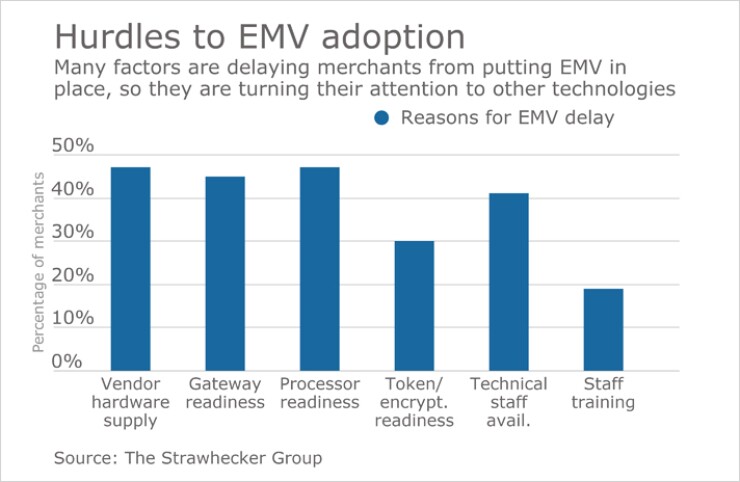The size of the U.S. payment card market prompted many issuers to keep things simple when they finally moved to support EMV.
They tended to stick with chip cards that have to be inserted, however a few companies are now looking to gain an edge by enabling Near Field Communication on the cards.
TCF Financial in Wayzata, Minn., is adding NFC to all newly issued EMV cards with the promise of quicker checkouts. The goal is to attack the widespread consumer perception that contact-only EMV debit cards take extra seconds to process at the point of sale.
“One of the biggest questions about EMV cards in the U.S. has been the issue of speed for the convenience of customers and merchants also looking to make transactions go faster," said Kevin Miller, senior vice president and director of products, marketing and customer service at TCF. “Our thought was that by issuing contactless debit cards, we could help customers speed up checkouts and it would be one more reason for them to use this card.”
Citigroup so far has made the broadest push into contactless EMV by equipping all of the credit cards it’s rolling out for its new cobranded Costco Visa credit with NFC, giving cardholders a quicker way to check out during this year’s crowded holiday shopping lines. Other large issuers, including American Express Co., are issuing NFC-enabled EMV credit cards, to customers upon request.
Relatively few issuers have adopted NFC for EMV debit cards, in part because debit EMV card distribution trailed credit cards, due largely to uncertainty over the technology needed to support merchant choices in U.S. debit network routing, which federal rules require.

Though only a small proportion of merchants support NFC—and Costco isn’t one of them—many large national retailers do, including Best Buy Co., Crate & Barrel, Bloomingdale’s and Macy’s. Citi recently said customer account sign-ups are brisk, recently passing the 1 million mark.
To accomplish its rollout of NFC-enabled EMV debit cards, TCF has installed card-issuing technology at the 341 branches it operates in seven mostly Midwestern states, Miller said.
TCF began issuing contactless EMV cards in September with new customers and it’s replacing older EMV debit cards with NFC-enabled cards in batches, Miller said. Customers also may walk into a branch and request a contactless EMV card to be issued immediately.
Immediacy is a big selling point for bank customers, Miller said.
TCF doesn’t issue its own credit cards directly. First National Bank of Omaha issues TCF-branded credit cards through an agent relationship, and so far those cards aren’t equipped with NFC, Miller said.
“Debit cards are a critical mechanism for our customers to be able to manage their money every day, and making that product more important and valuable is a high priority for us,” he said.
Outside the U.S., contactless EMV debit and credit cards are increasingly becoming the norm, especially in markets with dense urban populations, said Jack Jania, senior vice president of global alliances at Gemalto, which produces and provisions payment cards. NFC-enabled cards are expected to gain ground in cities like London with mass-transit systems that accept open-loop contactless cards, he added.
“Dual-interface EMV cards are gaining popularity in a lot of global markets, and as mobile payments expand and more terminals support NFC, the availability of contactless EMV cards is also helping to drive more incremental card volume, which is a top issuer goal,” Jania said.
But many U.S. issuers that just finished the mammoth job of converting all of their credit and debit card portfolios to EMV aren’t eager to do a costly mass-reissuance just yet merely to add the contactless capability, Jania suggested.
“It’s expensive to do a mass EMV rollout, and how issuers decide to set up their cards is a business decision they may revisit as chip cards become the more established routine for U.S. merchants and shoppers,” Jania said.
About a third of U.S. merchants have enabled EMV at payment terminals, and more than 80% of card issuers have completed their migration to chip cards, according to the latest industry figures.





